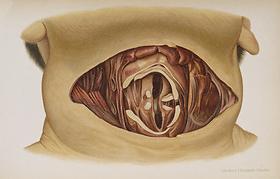Suicide by Cutting the Throat, 1898
Plate 16. Suicide by Cutting the Throat. The case was that of a young man in his twentieth year, who cut his throat in his room with a sharpened pocket-knife. He was found dead, on his back, in a moderate-sized pool of blood, his right hand covered with blood, and beside this a bloody pocket-knife. After cleansing the body the skin was not especially anemic, the post-mortem lividity fairly well developed, the visible mucous membranes not particularly pale, the wound of the neck running transversely from the middle of one sterno-cleido-mastoid muscle to the other.... [D]eath was not due to a fatal hemorrhage, but resulted from suffocation consequent upon entrance of the blood from the wound into the larynx and the lower respiratory passages.
Eduard Ritter von Hofmann, M.D., Atlas of Legal Medicine, Philadelphia, chromolithograph; Artist A. Schmitson
National Library of Medicine
